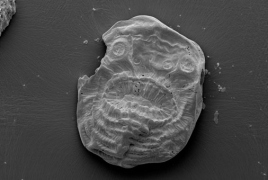
Humans' earliest known relative was likely an egg-shaped creature that ate and expelled from the same gaping orifice some 540 million years ago, scientists reported Monday, January 30, according to AFP.
Startlingly well-preserved fossils of the tiny beast, dubbed Saccorhytus, were discovered in central China's Shaanxi province, they reported in the journal Nature.
Several major branches of evolution -- one of them eventually leading to humans -- began from this inconspicuous, sea-dwelling organism, they speculated.
"This may represent the primitive beginnings of a very diverse range of species, including ourselves," said co-author Simon Conway Morris, a professor at Britain's University of Cambridge.
Saccorhytus belongs to a broad category of organisms called deuterostomes, and is the most ancient specimen unearthed so far.
Indeed, all deuterostomes -- vertebrates (animals with backbones), echinoderms (starfish and sea urchins) and other distinct groups -- are thought to have derived from this common ancestor, the study concluded.
To the naked eye, the fossils look like black grains of sand.
"But under the microscope, the level of detail is jaw dropping," Morris said.
The sack-like animal's most distinctive feature is a large -- relative to the rest of its body -- mouth ringed by concentric circles of raised bumps.
It probably ate by engulfing food particles and microscopic creatures.
Intriguingly, the researchers did not find anything corresponding to an anus, leading them to conclude that waste was expelled through the same hole.
The tiny beast also featured eight cone-like structures on its body that may have allowed the water it swallowed to escape -- probably "precursors to gill slits," Morris told AFP.
"But we have no evidence for eyes."

